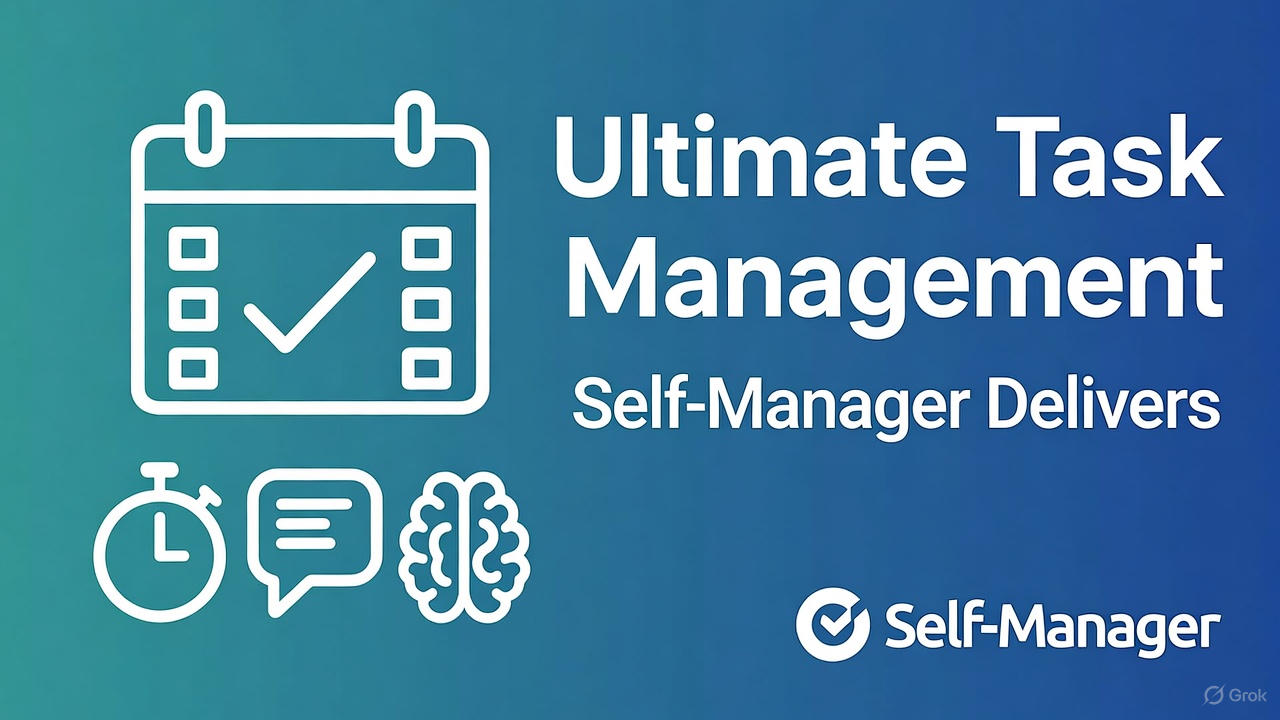What Every Task Management App Should Have — And How Self-Manager Delivers Them All
A practical checklist of must-have capabilities for modern task management

If a task manager doesn't help you capture instantly, review clearly, collaborate fluidly, and learn from your own patterns, it's not doing its job. Below is a practical checklist of must-have capabilities for modern task management—followed by how Self-Manager.net implements each one, end-to-end.
Self-Manager is built on a date-centric system (days → tables → rows) with weekly/monthly overviews, precise time tracking, real-time collaboration, and native AI—all running on an enterprise-grade Google Cloud/Firebase stack.
1) Fast task creation (capture at the speed of thought)
Why it matters: The faster you can capture, the more you'll actually use the system—and the less cognitive load you carry.
How Self-Manager does it: The UI is designed to feel "desktop-app fast" in the browser, with instant editing, drag-and-drop, and real-time sync—no reloads. Each day can hold unlimited tables (mini project boards) and each table has unlimited rows for tasks/notes, so you never "run out of space" when you're in flow.
2) Time tracking (know where the day actually went)
Why it matters: Without actuals, estimates drift and planning becomes fiction.
How Self-Manager does it: Built-in timers and completion markers track time per task and per table, feeding daily/weekly/monthly analytics so you can spot trends and rebalance workload. Recent updates added even more granular weekly/monthly allocation views.
3) Linking among projects (context that travels)
Why it matters: Work rarely lives in a single list. You need relationships between tasks in different boards/areas.
How Self-Manager does it: Create links across tables (even on different days) with completion percentages to keep dependencies visible without duplicating effort.
4) Image uploads (visual context on tap)
Why it matters: Screenshots, proofs, diagrams, and receipts belong with the task—not buried in a separate drive.
How Self-Manager does it: Attach up to 100 images per table (kept at original quality), and drag files directly into place while you work.
5) Notes (thinking space built-in)
Why it matters: Tasks without thinking space become cryptic. Notes capture decisions, specs, and learnings.
How Self-Manager does it: Add rich notes at the table, row (task), or comment level with unlimited text storage—all organized by date so your narrative stays in sequence.
6) Collaborators (invite your team without cost anxiety)
Why it matters: Collaboration is the point—but per-seat pricing punishes teams for inviting people early enough.
How Self-Manager does it:Unlimited collaborators on the Team plan—no per-seat fees. Everyone you invite can edit, comment, and organize in real time across devices.
7) Comments among collaborators (discuss where the work lives)
Why it matters: Context-rich discussion beats scattered DMs.
How Self-Manager does it: Threaded comments live right inside tables/tasks, alongside images and notes, so decisions are preserved with the work.
8) Periodic updates (ship improvements, not promises)
Why it matters: A task manager is your daily cockpit—stagnant tools quickly fall behind your workflow.
How Self-Manager does it:Continuous improvements are part of the product rhythm; you can track them in the public Updates playlist on YouTube (UI refreshes, ordering, analytics, more).
9) Solid uptime (trust the runway under your plane)
Why it matters: If your planner is down, your day stalls.
How Self-Manager does it: Built on Google Cloud + Firebase for security, scalability, and reliability, with a stated 99.99% uptime target in the platform overview.
10) Analytics (from "I feel busy" to "I know what works")
Why it matters: You can't improve what you don't measure.
How Self-Manager does it:Overview dashboards and time-tracking analytics at daily/weekly/monthly levels make patterns obvious—where time goes, completion velocity, and which tables drive outcomes.
11) Big-picture overview (zoom out without losing the day)
Why it matters: Great execution still needs great cadence—weeks and months give structure to sprints and seasons.
How Self-Manager does it: Switch to Weekly & Monthly views to plan, review, and rebalance. The date-centric model preserves a clean historical narrative that traditional board-only tools often lose.
12) Leverage the latest AI models (insight on demand)
Why it matters: AI turns scattered logs into summaries, reviews, and decisions—without manual synthesis.
How Self-Manager does it:Seven native AI features: table/period summaries, conversational chat about your data, task generation from raw text, and automated weekly/monthly reviews. You can choose between Fast and Thinking modes depending on depth vs. speed.
Why this combination works
Capture → Context → Collaboration → Insight: Self-Manager's date-first structure reduces overhead, while native AI and analytics convert activity into clarity.
Modern foundation: Real-time sync, cloud security, and reliability give you the confidence to run everything in one workspace.
Fair pricing: Individual ($5) and Team ($20 flat) plans keep collaboration affordable so you can invite everyone who needs a seat.
Keep exploring
How it Works – a guided tour of the date-centric workflow, overviews, time tracking, collaboration, and AI.
Articles – deep dives on features, technology, and philosophy (analytics, AI reviews, Google Cloud foundation, and more).
Updates playlist – watch the latest feature releases and UI improvements.
Ready to work with a tool that actually matches how you think?
Start your 7-day free trial and build a system that's fast, collaborative, and insight-rich from day one.

AI Powered Task Manager
Plan smarter, execute faster, achieve more
Create tasks in seconds, generate AI-powered plans, and review progress with intelligent summaries. Perfect for individuals and teams who want to stay organized without complexity.
Get started with your preferred account